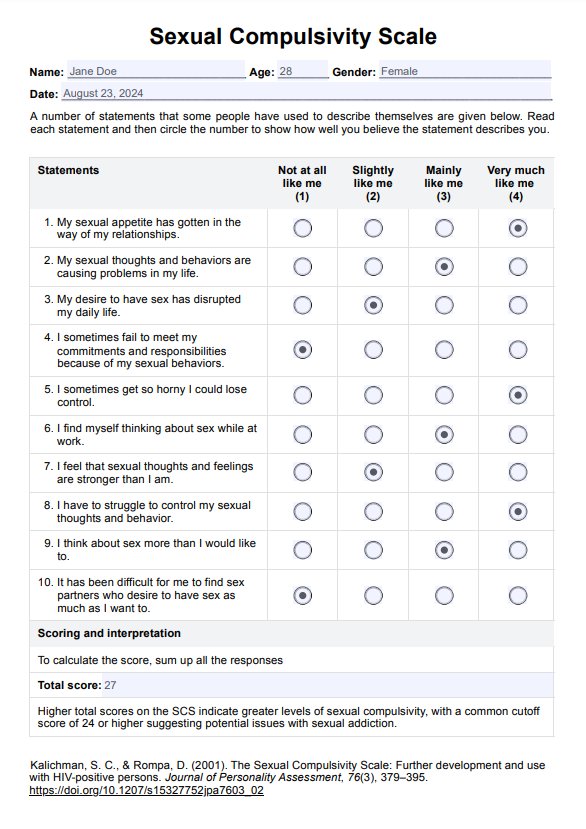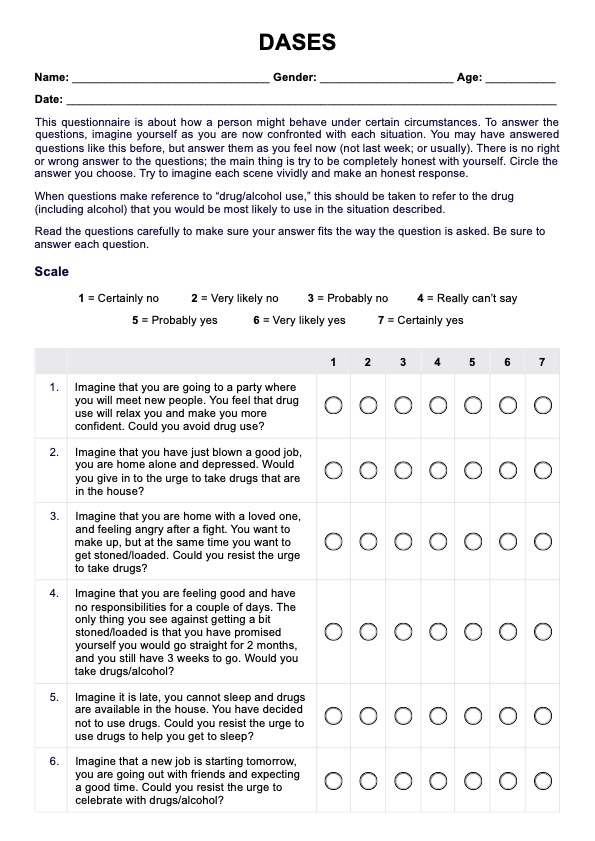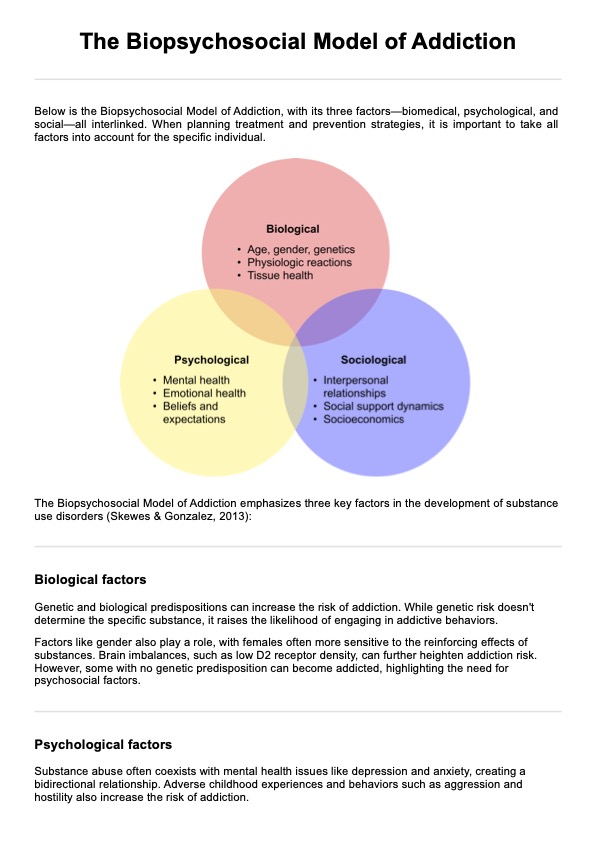Sexual Compulsivity Scale
Understand the causes, symptoms, and risks of sexually compulsive behavior. Use our Sexual Compulsivity Scale to identify and address sexual addiction.


What is sexual addiction?
Sexual addiction, also known as hypersexuality, is characterized by an overwhelming preoccupation with sexual thoughts, urges, or behaviors. These compulsive sexual behaviors can severely impact one’s daily life, relationships, work, and mental health. Understanding sexual addiction and compulsivity is crucial for identifying and managing the associated risks and complications.
Causes of excessive sexual behaviors
Sensation-seeking and sexual compulsivity can be caused by a variety of complex factors that interact with one another, including:
- Biological: An imbalance in brain chemicals, particularly neurotransmitters like dopamine and serotonin, can lead to compulsive sexual behavior. These chemicals play crucial roles in regulating mood and pleasure, and their dysregulation may create a cycle where individuals seek out sexual experiences to achieve temporary relief or satisfaction.
- Psychological: Individuals may develop sexual addiction as a response to past trauma, including abuse or neglect. Additionally, underlying mental health issues such as depression, anxiety, or obsessive-compulsive disorder can contribute to the compulsive pursuit of sexual activities as a coping mechanism.
- Social: Exposure to hypersexual environments, whether through media, peer influence, or unhealthy relationships, can normalize excessive sexual behavior. This constant exposure may lead individuals to adopt similar behaviors, blurring the lines between healthy sexual expression and addiction.
Symptoms of compulsive sexual behavior
Individuals experiencing sexual addiction may exhibit a range of symptoms that can significantly affect their lives:
- Persistent sexual fantasies, sexual impulses, and sexual feelings dominate thoughts, often leading to distraction and difficulty concentrating on other tasks.
- Difficulty controlling sexual thoughts and behaviors, resulting in impulsivity that overrides rational decision-making.
- Neglecting responsibilities, including work, family, and personal health, in favor of engaging in sexual activities or trying to find sex partners can lead to serious life disruptions.
- Engaging in risky sexual behaviors, such as unprotected sex or infidelity, can endanger not only their health but also their relationships, especially when involving multiple sexual partners or sex partners.
- Feelings of guilt or shame after sexual activities create a damaging cycle where the individual seeks more sexual experiences to escape negative feelings, only to feel worse afterward.
Risks of compulsive sexual sensation-seeking
Sexual addiction carries numerous risks that can have far-reaching consequences, including:
- Health risks: There is an increased likelihood of contracting sexually transmitted infections (STIs) due to reckless behaviors, as well as the possibility of unwanted pregnancies that can lead to emotional and financial stress. Maintaining a safe sexual practice becomes difficult when addiction takes precedence.
- Mental health: Heightened feelings of isolation can arise, as individuals may withdraw from social interactions and relationships. This isolation can exacerbate existing feelings of depression and anxiety, creating a downward spiral that is challenging to escape.
- Social and occupational: Strained relationships with family, friends, and partners can occur due to the prioritization of sexual activities over meaningful connections. Additionally, the potential for job loss emerges as neglected duties and responsibilities take a toll on professional performance, further contributing to feelings of inadequacy and distress.
Understanding the multifaceted nature of sexual addiction is crucial for those affected and for loved ones seeking to provide support.
Sexual Compulsivity Scale Template
Sexual Compulsivity Scale Example
What is the Sexual Compulsivity Scale (SCS)?
The Sexual Compulsivity Scale (SCS) is a validated tool used to measure the degree of sexual compulsivity in individuals. Seth Kalichman developed this tool assessment to assess tendencies toward sexual preoccupation, hypersexuality, and sexual addiction among young adults, men who have sex with men, and people displaying HIV-risk behaviors. The scale consists of 10 items rated on a 4-point Likert scale (1 = "Not at all like me" to 4 = "Very much like me").
The SCS is a different tool from Coleman and colleagues' Compulsive Sexual Behavior Inventory (CSBI).
Psychometric properties of the Sexual Compulsivity Scale
The scale has demonstrated strong psychometric properties:
- Internal consistency: Excellent, with a Cronbach's alpha coefficient ranging from 0.76 to 0.92 in various samples, including gay and bisexual men, African American men and women, and HIV-positive individuals.
- Temporal stability: Consistently reliable over time; test-retest reliability of 0.95 over two weeks and ranged from 0.64 to 0.80 over a longer 3-month period.
- Validity: Strong correlations with various measures of sexual behavior, mental health, and risk factors for STIs, especially among HIV-positive men and those engaged in high-risk sexual practices.
How to use our Sexual Compulsivity Scale PDF template?
Using our SCS PDF template is straightforward:
- Access the template: Click the "Use template" button to access the free SCS PDF.
- Administer the scale: Present the scale to your client and instruct them to rate each item based on their recent experiences. Each of the ten items on the scale is rated from 1 to 4, with 1 indicating "Not at all like me" and 4 indicating "Very much like me."
- Review responses: Calculate the responses to assess the severity of sexual compulsivity and review it with your client.
How to score our Sexual Compulsivity Scale
To score the SCS, simply add the scores to obtain a total score between 10 and 40.
- Scores 10-23: Indicate a lower likelihood of sexual compulsivity.
- Scores 24-40: Suggest a higher likelihood of sexual compulsivity.
The total score will guide you in determining the appropriate level of intervention needed, from basic counseling to more intensive therapeutic approaches.
Next steps after using the scale
Once you have administered and scored the SCS, consider the following steps to enhance your client's care:
- Discuss results: Share the findings with your client, providing context and clarity. Encourage an open dialogue to help them understand their results.
- Develop a treatment plan: Based on the score, create a tailored treatment plan that addresses both the compulsive behaviors and any underlying psychological issues for their strong sexual urges. This personalized approach will enhance the effectiveness of the intervention.
- Monitor progress: Schedule periodic follow-ups using the SCS to track changes to ther sexual appetite over time. Adjust treatment strategies as necessary based on the client’s progress and evolving needs.
Commonly asked questions
The Sexual Compulsivity Scale (SCS) is a 10-item self-report measure developed by Seth Kalichman to assess tendencies toward sexual preoccupation, hypersexuality, and sexual addiction. It has been extensively used in research to study the relationship between sexual compulsivity and high-risk sexual behaviors, particularly among men who have sex with men (MSM) and people living with HIV (PWH).
The Sexual Compulsivity Scale (SCS) is scored by summing the 10 individual item responses to obtain a total score, which can range from 10 to 40. Higher scores indicate greater levels of sexual compulsivity. A commonly used cutoff score is 24 or higher, suggesting potential sexual addiction, although this should be interpreted cautiously and in conjunction with other clinical information.
For people who are HIV positive, understanding seurges cartant because having strong sexual ors, like not using protection. This can increase the chance of spreading HIV to others or getting other infections. It’s important to manage these behaviors to stay healthy.

.jpg)



















-template.jpg)


















































































